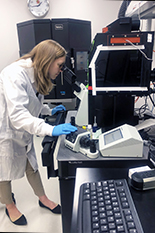Stroka Receives NSF CAREER Award for Cell Mechanobiology Research
Fischell Department of Bioengineering assistant professor and alumna Kimberly Stroka (Ph.D. ‘11) was named a recipient of the National Science Foundation’s Faculty Early Career Development (CAREER) award. The five-year, $600,000 award will support Stroka’s efforts to advance understanding of the field of endothelial cell mechanobiology and enable her to form the infrastructure for a transformative STEM education, mentoring, and outreach program. Along the interior surface of blood vessels lie endothelial cells. These cells form the endothelium, a semi-selective barrier that allows certain ions, molecules, and cells – including white blood cells – to pass into and out of the bloodstream, while, in healthy situations, preventing potentially harmful substances from doing the same. Unfortunately, at times, the endothelium is so effective a barrier that it blocks drug delivery into tissues from the vasculature – creating added challenges for targeting therapies to specific areas of the body to treat diseases or cancer. The selective permeability of the vascular endothelium is controlled in part by what are known as junction proteins. These junctions serve as fusion points between cells, and are made up of numerous proteins that join together to form a barrier. The relative contributions of different junction proteins, their spatial assembly, and how they function, depends on the vascular bed containing the endothelium. For example, the brain endothelium has a high expression of tight junction proteins that form a tight barrier to protect the brain tissue, while the lymphatic endothelium has “button-like” junctions that are much leakier to promote drainage of macromolecules and fluid from tissues. Changes in cell-cell junctions could lead to endothelial dysfunction, and consequently, diseases such as hypertension, coronary artery disease, or diabetes. In order to advance understanding of how mechanical conditions, genetic alterations, and other factors might alter cell-cell junctions in endothelial cells from different vascular beds, Stroka and her Cell and Microenvironment Lab group developed the Junction Analyzer Program (JAnaP), a Python-based program capable of providing quantitative metrics that describe the integrity of cell junction proteins in response to different biochemical and physical cues. Such a program could prove invaluable as, to date, there are no models or techniques that can be used to efficiently quantify junctional proteins as they are assembled at the cell edge. Stroka’s lab will combine the JAnaP with an innovative local permeability assay that can quantify, at a subcellular level, where molecules are penetrating the endothelium. Stroka and her team aim to use JAnaP to determine how different endothelial cell-cell junction characteristics and external mechanical cues affect the endothelium’s permeability and function. “Our motto for this project is, ‘Junction, Junction, what’s your function?’ The goal is to identify the relationship between the form [spatial organization], function [permeability], and mechanics [cell-cell tension] of endothelial cell-cell junctions, and how these characteristics of the junction are regulated in different vascular beds over time. Ultimately, this work could enable us to make image-based predictions about endothelial barrier integrity in in vitro disease or drug delivery models, and, eventually, in in vivo vessels. In addition, the work could lead to improved drugs for cardiovascular or neurovascular diseases.” In addition to their work in the lab, the group will apply Stroka’s NSF grant towards developing a transformative education and outreach plan. Their hope is to develop a framework for training, equipping, and educating K-12, undergraduate, and graduate students at the interface of engineering and biology. “The long-term goal of our outreach initiatives is to increase student exposure to, and broaden participation in, STEM research, training, and career opportunities, and to increase the number and diversity of students entering STEM career fields or majors,” Stroka said.
Related Articles: February 26, 2020 Prev Next |


